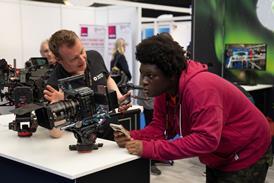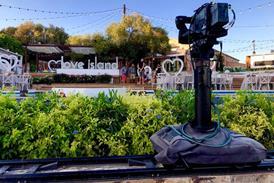We take a look at some of the key announcements and unveilings that took place at the broadcast equipment extravaganza.
4K is for all…
The safest bet in Las Vegas was that NAB 2014 would see the rollout of more tools for acquiring, enhancing, managing and delivering 4K content.
On the acquisition front, AJA and Blackmagic Design didn’t disappoint, with the unveiling of the Cion and Ursa respectively.
Although AJA’s entry into the camera market was a surprise, it certainly makes sense given the company’s area of expertise (one observer on Twitter described the camera as a Ki Pro Quad with a sensor).
Panasonic’s VariCam was on show too, two years after the prototype was unveiled at NAB 2012.
And JVC got in on the act with a “technology demonstration” of the GY-LSX1, a 4K camera equipped with a Super 35mm sensor and a PL lens mount.
All of these devices serve a very specific segment of the market - one that is starting to look a little congested – and so it was the widening application of 4K that was one of the more interesting developments at NAB.
The launch of a shoulder-mount rig for Sony’s F55 should make the camera more appealing to factual and documentary programme makers and those who prefer an ENG-style approach to shooting.
And Canon’s 4K-ready Cine-Servo lens, which was unveiled a week before NAB and on show for the first time in Las Vegas, is likely to serve the same crowd.
Meanwhile, Grass Valley will hope that its three-sensor, LDX 4K camera with a B4 lens mount will provide the live sports market with the tool needed to shoot 4K content without having to use PL-mount cameras and a host of workarounds.
…and 8K is just around the corner
Over in the NAB Labs Futures Park, NHK showed off its very compact 8K Cube camera, along with an 8K over-the-air transmission demonstration.
NHK partner Hitachi also had an 8K camera channel on display, while Ikegami’s stand featured a prototype of an 8K camera.
Avid can still excite
Avid’s three-day customer conference and announcements about changes to its suite of editing tools and the launch of its MediaCentral platform ensured it was the most talked about company at NAB before the show had even opened.
Some of the members of its numerous advisory councils that met for the first time in Las Vegas used gambling parlance to describe the firm’s strategy: “They’ve bet the house on this” was one description of the company’s decision to open up to third party integration and switch to licences for its software.
Although the confernece on Saturday bordered on the evangelical at times (being played out to the ‘Avid Everywhere’ song at the end was probably a bit much) the one thing that everyone seemed to agree on was that new chief exec Louis Hernandez has given the company a much-needed lift.
Prices continue to fall
Aside from the launch of more large sensor, 4K-capable cameras for a few thousand pounds, Digital Vision slashed the price of its grading software Nucoda to £1,650 in response to what managing director Kelvin Bolah described as “the destructive and destabilising commoditisation of this niche market”.
The company said it made the dramatic price cut because it wants to protect its customer base and that its other products, such as Precision and Tangent grading panels and its scanning and restoration tools would help it absorb the price drop.
The first outcome of Blackmagic’s acquisition of Cintel was also revealed.
Without a firm release date and the company encouraging feedback on the model on show in Las Vegas, the film scanner seems to be a work in progress, but with a price tag that looks like it’s missing a zero (around £18,000) it’s bound to attract interest.
The industry is still consolidating
NAB provided an opportunity for newly merged companies such as Quantel/Snell and Belden/Grass Valley/Miranda to meet their clients as combined entities for the first time, but a week in Las Vegas wasn’t going to stop to the recent glut of acquisitions from continuing.
Dalet’s deal for Amberfin was sealed on Saturday evening, just 36 hours before the exhibition opened, and Imagine Communications (formerly Harris Broadcast) announced it had bought Digital Rapids on the first day of the exhibition.
IP is key
One of the common areas of interest among the recently merged Quantel and Snell is IP-based networks.
Quantel sees the shift to IP infrastructure as “the biggest transition since [the industry] went digital 30 years ago”, while Snell demonstrated integration between its broadcast infrastructure kit and Cisco’s IP and MPLS networking.
It also announced proof of concept trials with studios in the US and the UK at an unnamed news studio, which will use beta versions of production switchers, control systems and some of Snell’s conversion equipment.
And one of the International Association of Broadcasting Manufacturers (IABM) Game Changer Awards went to Axon with its Neuron AV Bridging (other winners included Atomos with Shogun; Bridge Technology with VB288 Objective QoE Content Extractor; Grass Valley with GV Stratus; and SDN² with Warp), which offers frame accurate IP switching.
Drones are de rigueur
Unmanned aerial vehicles and drones, which caused such a stir at last year’s show, are well and truly accepted as just another production tool.
While the DJI stand in Central Hall was busy, it didn’t generate the same level of frenetic activity as last year.
Further evidence of the maturation of the market was shown with Atomos’ launch of its Ninja Star device, targeted specifically at drone users who want to capture ProRes, and JVC’s mini 4K camera, the GW-SPLS1, which is aimed squarely at the UAV market.




























No comments yet